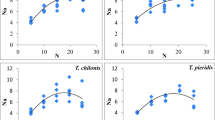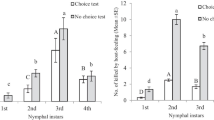Abstract
To improve the biological control of Tuta absoluta (Meyrick) (Lepidoptera: Gelechiidae), we studied the life history traits and host-killing rate of Neochrysocharis formosa (Westwood) (Hymenoptera: Eulophidae) on T. absoluta at 25 ± 0.5 °C, 70 ± 5% RH and a L:D 14:10 photoperiod. The parasitoid was able to parasitize and host feed on the first, second and third instar host larvae with preference to the second instar. Life history traits and host-killing parameters were highest on the second instar host larvae compared to the first or third instar. The host-killing rate of the parasitoid was much higher than the intrinsic rate of increase. N. formosa appeared to be a potential biocontrol agent of T. absoluta and would supplement its biological control in tomato involving other biocontrol agents like Nesidiocoris tenuis (Reuter) and Necremnus spp.




Similar content being viewed by others
Change history
09 November 2020
There was an error in the originally published Fig. 4. The correct figure is shown below.
References
Ballal CR, Gupta A, Mohan M, Lalitha Y, Verghese A (2016) The new invasive pest Tuta absoluta (Meyrick) (Lepidoptera: Gelechiidae) in India and its natural enemies along with evaluation of Trichogrammatids for its biological control. Curr Sci 110:2155–2159
Benelli G, Giunti G, Tena A, Desneux N, Caselli A, Canale A (2017) The impact of adult diet on parasitoid reproductive performance. J Pest Sci 90:807–823
Bernardo U, Pedata PA, Viggiani G (2006) Life history of Pnigalio soemius (Walker) (Hymenoptera: Eulophidae) and its impact on a leafminer host through parasitization, destructive host-feeding and host-stinging behavior. Biol Control 37:98–107
Biondi A, Narciso R, Guedes C, Wan FH, Desneux N (2018) Ecology, worldwide spread, and management of invasive south American tomato pin worm, Tuta absoluta: past, present and future. Ann Rev Entomol 63:239–258
Birch LC (1948) The intrinsic rate of natural increase in an insect population. J Anim Ecol 17:15–26
Bodino N, Ferracini C, Tavella L (2018) Functional response and age-specific foraging behaviour of Necremnus tutae and N. cosmopterix, native natural enemies of the invasive pest Tuta absoluta in Mediterranean area. J Pest Sci 92:1467–1478
CABI (2020) Invasive species compendium: Datasheet Tuta absoluta. https://www.cabi.org/isc/datasheet/49260. Accessed 21 Jan 2020
Calvo FJ, Soriano JD, Bolckmans K, Belda JE (2013) Host instar suitability and life history parameters under different temperature regimes of Necremnus artynes on Tuta absoluta. Biol Sci Technol 23:803–815
Carey JR (2001) Insect biodemography. Ann Rev Entomol 46:79–110
Chailleux A, Desneux N, Arno J, Gabarra R (2014) Biology of two key palaearctic larval ectoparasitoids when parasitizing the invasive pest Tuta absoluta. J Pest Sci 87:441–448
Chailleux A, Droui A, Bearez P, Desneux N (2017) Survival of a specialist natural enemy experiencing resource competition with an omnivorous predator when sharing the invasive prey Tuta absoluta. Ecol Evol 7:8329–8337
Cheng XQ, Cao FQ, Zhang YB, Guo JY, Wan FH, Liu WX (2017) Life history and life table of the host-feeding parasitoid Hemiptarsenus varicornis (Hymenoptera: Eulophidae). Appl Entomol Zool 52:287–293
Chien CC, Ku SC (2001a) Appearance and life history of Neochrysocharis formosa (Hymenoptera: Eulophidae). Formos Entomol 21:383–393
Chien CC, Ku SC (2001b) Instar preference of five species of parasitoids of Liriomyza trifolii (Hymenoptera: Eulophidae, Braconidae). Formos Entomol 21:89–97
Desneux N, Luna MG, Guillemaud T, Urbaneja A (2011) The invasive South American tomato pinworm, Tuta absoluta continues to spread in Afro-Eurasia and beyond: the new threat to tomato world production. J Pest Sci 84:403–408
Desneux N, Wajnberg E, Wyckhuys KAG, Burgio G, Arpaia S, Narváez-Vasquez CA, González-Cabrera J, Catalán Ruescas D, Tabone E, Frandon J, Pizzol J, Poncet C, Cabello T, Urbaneja A (2010) Biological invasion of European tomato crops by Tuta absoluta: ecology, history of invasion and prospects for biological control. J Pest Sci 83:197–215
Desouhant E, Driessen G, Amat I, Bernstein C (2005) Host and food searching in a parasitic wasp Venturia canescens: a trade-off between current and future reproduction? Anim Behav 70:145–152
El-Wakeil N, Gaafar N, Sallam A (2013) Side effects of insecticides on natural enemies and possibility of their integration in plant protection strategies. In: Trdan S (ed) Insecticides—development of safer and more effective technologies, pp 1–56.
Favero K, Pereira FF, Kassab SO, Costa DP, Zanuncio JC (2014) Life and fertility tables of Trichospilus diatraeae (Hymenoptera: Eulophidae) with Tenebrio molitor (Coleoptera: Tenebrionidae) pupae. Ann Entomol Soc Am 107:621–626
Fisher N, Ubaidillah R, Reina P, La Salle J (2008) Liriomyza parasitoids of south-east Asia. https://keys.lucidcentral.org/keys/v3/Liriomyza/
Guedes RNC, Roditakis E, Campo MR, Haddi K, Bielza P, Siqueira HAA, Tsagkarakou A, Vontas J, Nauen R (2019) Insecticide resistance in tomato pinworm Tuta absoluta: patterns, spread, mechanisms, management and outlook. J pest Sci 92:1329–1342
Khan MA, Agnihotri M, Sushil SN (2005) Taxonomic studies of eulophid parasitoids (Hymenoptera: Chalcidoidea) of India. Pantnagar J Res 2:1–230
LaSalle J, Parrella MP (1991) The chalcidoid parasite (Hymenoptera, Chalcidoidea) of economically important Liriomyza species (Diptera: Agromyzidae) in north America. Proc Entomol Soc Wash 93:571–591
Liu T, Kang L, Heinz KM, Trumble J (2009) Biological control of Liriomyza leafminers progress and perspective. Persp Agric Vet Sci Nutr Nat Res 4:1–16
Liu WX, Wang WX, Zhang YB, Lu SH, Wang W, Wan FH (2015) Adult diet affects the life history and host-killing behavior of a host-feeding parasitoid. Biol Control 81:58–64
Luna MG, Sanchez NE, Pereyra PC (2007) Parasitism of Tuta absoluta (Lepidoptera: Gelechiidae) by Pseudapanteles dignus (Hymenoptera: Braconidae) under laboratory conditions. Environ Entomol 36:887–893
Luna MG, Wada VI, LaSalle J, Sanchez NE (2011) Neochrysocharis formosa (Westwood) (Hymenoptera: Eulophidae), a newly recorded parasitoid of the tomato moth, Tuta absoluta (Meyrick) (Lepidoptera: Gelechiidae), in Argentina. Neotrop Entomol 40:412–414
Maia N, De HA, Luiz AJB, Campanhola C (2000) Statistical inference on associated fertility life table parameters using jackknife technique: computational aspects. J Econ Entomol 93:511–518
Manohar TN, Sharma PL, Verma SC, Sharma KC, Chandel RS (2020) Functional response of indigenous Trichogramma spp. to invasive tomato leafminer, Tuta absoluta (Meyrick) under laboratory conditions. Int J Trop Insect Sci 40:101–107
Meyer JS, Igersoll CG, MacDonald LL, Boyce MS (1986) Estimating uncertainty in population growth rates: jackknife vs. bootstrap techniques. Ecology 67:1156–1166
Naselli M, Biondi A, Garzia GT (2017) Insights into food webs associated with the South American tomato pinworm. Pest Manag Sci 73:1352–1357
Negi S, Sharma PL, Sharma KC, Verma SC (2018) Effect of host plants on developmental and population parameters of invasive leafminer, Tuta absoluta (Meyrick) (Lepidoptera: Gelechiidae). Phytoparasitica 46:213–221
Noyes JS (2019) Universal chalcidoidea database: worldwide web electronic publication. https://www.nhm.ac.uk/our-science/data/chalcidoids/database/
Patel KJ, Schuster DJ, Smerage GH (2003) Density dependent parasitism and host-killing of Liriomyza trifolii (Diptera: Agromyzidae) by Diglyphus intermedius (Hymenoptera: Eulophidae). Fla Entomol 86:8–14
Savino V, Coviella CE, Luna MG (2012) Reproductive biology and functional response of Dineulophus phtorimaeae, a natural enemy of the tomato moth, Tuta absoluta. J Insect Sci 12:153
Sapkal SD, Sonkamble MM, Savde VG (2018) Bioefficacy of newer insecticides against tomato leaf miner, Tuta absoluta (meyrick) on tomato, Lycopersicon esculentum (Mill) under protected cultivation. Int J Chem Stud 6:3305–3309
Sharma PL, Kumar R (2017) Diversity and abundance of parasitoids of Liriomyza trifolii in northwestern Himalayas, India. Bioscan 12:715–720
Sharma PL, Gavkare O (2017) New distributional record of invasive pest, T. absoluta (Meyrick) in north western Himalayan region of India. Nat Acad Sci Lett 40:217–220
Shashank PR, Chandrashekar K, Meshram NM, Sreedevi K (2015) Occurrence of Tuta absoluta (Gelechiidae: Lepidoptera) an invasive pest from India. Indian J Entomol 77:323–329
Sheoran OP, Tonk DS, Kaushik LS, Hasija RC, Pannu RS (1998) Statistical software package for agricultural research workers. In: Hooda DS, Hasija RC (eds) Recent advances in information theory, statistics and computer applications. CCS HAU, Hisar, pp 139–143
Sohrabi F, Lotfalizadeh H, Salehipour H (2014) Report of a larval parasitoid of Tuta absoluta. J Plant Prot Res 54:306–307
Sridhar V, Chakravarthy AK, Asokan R, Vinesh LS, Rebijith KB, Vennila S (2014) New records of invasive South American tomato leaf miner, Tuta absoluta (Meyrick) (Lepidoptera: Gelechiidae) in India. Pest Manag Hortic Ecos 20:148–154
Singh V, Sharma N, Sharma SK (2016) A review on effects of new chemistry insecticides on natural enemies of crop pests. Int J Sci Env Technol 5:4339–4361
Tonnang HEZ, Mohamed SF, Khamis F, Ekesi S (2015) Identification and risk assessment for worldwide invasion and spread of Tuta absoluta with a focus on sub-Saharan Africa: implications for phytosanitary measures and management. PLoS ONE 10(9):e0138319
Urbaneja A, Monton H, Molla O (2009) Suitability of the tomato borer Tuta absoluta as prey for Macrolophus pygmaeus and Nesidiocoris tenuis. J Appl Entomol 133:292–296
Urbaneja AR, Vercher V, Navarro F, Garcia M, Porcuna JL (2007) La pollila del tomate, Tuta absoluta. Phytoma España 194:16–23
van Lenteren JC, Bueno VHP, Burgio G, Lanzoni A, Montes FC, Silva DB, de Jong PW, Hemerik L (2019) Pest kill rate as aggregate evaluation criterion to rank biological control agents: a case study with Neotropical predators of Tuta absoluta on tomato. Bull Entomol Res 109:812–820
Wang W, Wang WX, Liu WX, Cheng LS, Wan FH (2012) Research advances on biological characteristics and application of Neochrysocharis formosa (Westwood) (Hymenoptera: Eulophidae). Chinese J Biol Control 28:575–582
Wang WX, Wang W, Lu SL, Wan FH, Liu WX (2013) Research advances in biological characteristics and application of Neochrysocharis okazakii (Kamijo) (Hymenoptera: Eulophidae: Eulophinae). J Biosafety 22:1–7
Xuan JL, Liu WX, Zhang YB, Cheng XQ, Guo JY, Wan FH (2018) Interactions between Diglyphus isaea and Neochrysocharis formosa (Hymenoptera: Eulophidae), two parasitoids of agromyzid leafminers. Biol Control 126:45–52
Ye FY, Zhu CD, Yefremova Z, Liu WX, Guo JY, Wan FH (2018) Life history and biocontrol potential of the first female producing parthenogenetic species of Diglyphus (Hymenoptera: Eulophidae) against agromyzid leafminers. Sci Rep 8:3222
Zhang YB, Lu SL, Liu WX, Wang WX, Wang W, Wan FH (2014) Comparing immature development and life history traits in two coexisting host-feeding parasitoids, Diglyphus isaea and Neochrysocharis formosa (Hymenoptera: Eulophidae). J Integ Agric 13:2690–2700
Acknowledgments
The authors are thankful to the Indian Council of Agricultural Research, New Delhi, India for providing financial support to the study. Authors also acknowledge the efforts of Dr Neeraj, professor of English, for checking the manuscript for English language.
Author information
Authors and Affiliations
Corresponding author
Ethics declarations
Conflict of interest
The authors declare that they have no conflict of interest.
Additional information
Handling Editor: Stefano Colazza.
Rights and permissions
About this article
Cite this article
Guleria, P., Sharma, P.L., Verma, S.C. et al. Life history traits and host-killing rate of Neochrysocharis formosa on Tuta absoluta. BioControl 65, 401–411 (2020). https://doi.org/10.1007/s10526-020-10016-z
Received:
Accepted:
Published:
Issue Date:
DOI: https://doi.org/10.1007/s10526-020-10016-z




